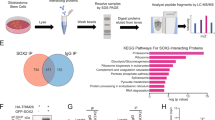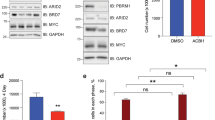Abstract
The transcription factor Sox4 is aberrantly expressed in many human tumors and can modulate tumorigenesis and metastases of murine tumors in vivo. However, mechanisms that control Sox4 function remain poorly defined. It has recently been observed that DNA damage increases Sox4 protein expression independently of Sox4 mRNA levels, suggesting an as yet undefined post-transcriptional mechanism regulating Sox4 expression and functionality. Here, we show that Sox4 protein is rapidly degraded by the proteasome as indicated by pharmacological inhibition with Mg132 and epoxymycin. Sox4 half-life was found to be less than 1 h as evident by inhibition of protein synthesis using cycloheximide. Ectopic expression of Sox4 deletion mutants revealed that the C-terminal 33 residues of Sox4 were critical in modulating its degradation in a polyubiquitin-independent manner. Syntenin, a Sox4 binding partner, associates with this domain and was found to stabilize Sox4 expression. Syntenin-induced stabilization of Sox4 correlated with Sox4-syntenin relocalization to the nucleus, where both proteins accumulate. Syntenin overexpression or knockdown in human tumor cell lines was found to reciprocally modulate Sox4 protein expression and transcriptional activity implicating its role as a regulator of Sox4. Taken together, our data demonstrate that the Sox4 C-terminal domain regulates polyubiquitin-independent proteasomal degradation of Sox4 that can be modulated by interaction with syntenin. As aberrant Sox4 expression has been found associated with many human cancers, modulation of Sox4 proteasomal degradation may impact oncogenesis and metastatic properties of tumors.
This is a preview of subscription content, access via your institution
Access options
Subscribe to this journal
Receive 50 print issues and online access
$259.00 per year
only $5.18 per issue
Buy this article
- Purchase on Springer Link
- Instant access to full article PDF
Prices may be subject to local taxes which are calculated during checkout






Similar content being viewed by others
References
Asher G, Reuven N, Shaul Y . (2006). 20S proteasomes and protein degradation “by default”. Bioessays 28: 844–849.
Asher G, Shaul Y . (2006). Ubiquitin-independent degradation: lessons from the p53 model. Isr Med Assoc J 8: 229–232.
Basbous J, Jariel-Encontre I, Gomard T, Bossis G, Piechaczyk M . (2008). Ubiquitin-independent- versus ubiquitin-dependent proteasomal degradation of the c-Fos and Fra-1 transcription factors: is there a unique answer? Biochimie 90: 296–305.
Beekman JM, Bakema JE, van de Winkel JGJ, Leusen JHW . (2004). Direct interaction between FcgammaRI (CD64) and periplakin controls receptor endocytosis and ligand binding capacity. Proc Natl Acad Sci USA 101: 10392–10397.
Beekman JM, Coffer PJ . (2008). The ins and outs of syntenin, a multifunctional intracellular adaptor protein. J Cell Sci 121: 1349–1355.
Beekman JM, Verhagen LP, Geijsen N, Coffer PJ . (2009). Regulation of myelopoiesis through syntenin-mediated modulation of IL-5 receptor output. Blood 114: 3917–3927.
Belizario JE, Alves J, Garay-Malpartida M, Occhiucci JM . (2008). Coupling caspase cleavage and proteasomal degradation of proteins carrying PEST motif. Curr Protein Pept Sci 9: 210–220.
Bergsland M, Werme M, Malewicz M, Perlmann T, Muhr J . (2006). The establishment of neuronal properties is controlled by Sox4 and Sox11. Genes Dev 20: 3475–3486.
Bhattaram P, Penzo-Mendez A, Sock E, Colmenares C, Kaneko KJ, Vassilev A . (2010). Organogenesis relies on SoxC transcription factors for the survival of neural and mesenchymal progenitors. Nat Commun 1: 9.
Boukerche H, Aissaoui H, Prévost C, Hirbec H, Das SK, Su ZZ . (2010). Mda-9/Syntenin promotes metastasis in human melanoma cells by activating c-Src. Oncogene 29: 3054–3066.
Boukerche H, Su ZZ, Prévot C, Sarkar D, Fisher PB . (2008). Src kinase activation is mandatory for MDA-9/syntenin-mediated activation of nuclear factor-kappaB. Proc Natl Acad Sci USA 105: 15914–15919.
Bowles J, Schepers G, Koopman P . (2000). Phylogeny of the SOX family of developmental transcription factors based on sequence and structural indicators. Dev Biol 227: 239–255.
Dy P, Penzo-Mendez A, Wang H, Pedraza CE, Macklin WB, Lefebvre V . (2008). The three SoxC proteins—Sox4, Sox11 and Sox12—exhibit overlapping expression patterns and molecular properties. Nucleic Acids Res 36: 3101–3117.
Dyson HJ, Wright PE . (2005). Intrinsically unstructured proteins and their functions. Nat Rev Mol Cell Biol 6: 197–208.
Elenbaas B, Spirio L, Koerner F, Fleming MD, Zimonjic DB, Donaher JL . (2001). Human breast cancer cells generated by oncogenic transformation of primary mammary epithelial cells. Genes Dev 15: 50–65.
Fietta P, Delsante G . (2010). Proteasomes and immunoproteasomes. Riv Biol 103: 29–50.
Geijsen N, Uings IJ, Pals C, Armstrong J, McKinnon M, Raaijmakers JA . (2001). Cytokine-specific transcriptional regulation through an IL-5Ralpha interacting protein. Science 293: 1136–1138.
Goldberg AL . (2003). Protein degradation and protection against misfolded or damaged proteins. Nature 426: 895–899.
Grootjans JJ, Zimmermann P, Reekmans G, Smets A, Degeest G, Dürr J . (1997). Syntenin, a PDZ protein that binds syndecan cytoplasmic domains. Proc Natl Acad Sci USA 94: 13683–13688.
Hoser M, Potzner MR, Koch JM, Bosl MR, Wegner M, Sock E . (2008). Sox12 deletion in the mouse reveals nonreciprocal redundancy with the related Sox4 and Sox11 transcription factors. Mol Cell Biol 28: 4675–4687.
Hunt SM, Clarke CL . (1999). Expression and hormonal regulation of the Sox4 gene in mouse female reproductive tissues. Biol Reprod 61: 476–481.
Kerscher O, Felberbaum R, Hochstrasser M . (2006). Modification of proteins by ubiquitin and ubiquitin-like proteins. Annu Rev Cell Dev Biol 22: 159–180.
Krappmann D, Wulczyn FG, Scheidereit C . (1996). Different mechanisms control signal-induced degradation and basal turnover of the NF-kappaB inhibitor IkappaB alpha in vivo. EMBO J 15: 6716–6726.
Kruger E, Kloetzel PM, Enenkel C . (2001). 20S proteasome biogenesis. Biochimie 83: 289–293.
Kwak J, Workman JL, Lee D . (2010). The proteasome and its regulatory roles in gene expression. Biochim Biophys Acta 1809: 88–96.
Lambaerts K, Wilcox-Adelman SA, Zimmermann P . (2009). The signaling mechanisms of syndecan heparan sulfate proteoglycans. Curr Opin Cell Biol 21: 662–669.
Lin JJ, Jiang H, Fisher PB . (1998). Melanoma differentiation associated gene-9, mda-9, is a human gamma interferon responsive gene. Gene 207: 105–110.
Lund AH, Turner G, Trubetskoy A, Verhoeven E, Wientjens E, Hulsman D . (2002). Genome-wide retroviral insertional tagging of genes involved in cancer in Cdkn2a-deficient mice. Nat Genet 32: 160–165.
Malki S, Boizet-Bonhoure B, Poulat F . (2010). Shuttling of SOX proteins. Int J Biochem Cell Biol 42: 411–416.
Medina PP, Castillo SD, Blanco S, Sanz-Garcia M, Largo C, Alvarez S . (2009). The SRY-HMG box gene, SOX4, is a target of gene amplification at chromosome 6p in lung cancer. Hum Mol Genet 18: 1343–1352.
Nissen-Meyer LS, Jemtland R, Gautvik VT, Pedersen ME, Paro R, Fortunati D . (2007). Osteopenia, decreased bone formation and impaired osteoblast development in Sox4 heterozygous mice. J Cell Sci 120: 2785–2795.
Pan X, Zhao J, Zhang WN, Li HY, Mu R, Zhou T . (2009). Induction of SOX4 by DNA damage is critical for p53 stabilization and function. Proc Natl Acad Sci USA 106: 3788–3793.
Penzo-Mendez AI . (2010). Critical roles for SoxC transcription factors in development and cancer. Int J Biochem Cell Biol 42: 425–428.
Potzner MR, Tsarovina K, Binder E, Penzo-Mendez A, Lefebvre V, Rohrer H . (2010). Sequential requirement of Sox4 and Sox11 during development of the sympathetic nervous system. Development 137: 775–784.
Prakash S, Tian L, Ratliff KS, Lehotzky RE, Matouschek A . (2004). An unstructured initiation site is required for efficient proteasome-mediated degradation. Nat Struct Mol Biol 11: 830–837.
Rechsteiner M, Rogers SW . (1996). PEST sequences and regulation by proteolysis. Trends Biochem Sci 21: 267–271.
Reits EA, Benham AM, Plougastel B, Neefjes J, Trowsdale J . (1997). Dynamics of proteasome distribution in living cells. EMBO J 16: 6087–6094.
Rhodes DR, Yu J, Shanker K, Deshpande N, Varambally R, Ghosh D . (2004). Large-scale meta-analysis of cancer microarray data identifies common transcriptional profiles of neoplastic transformation and progression. Proc Natl Acad Sci USA 101: 9309–9314.
Sarkar D, Boukerche H, Su ZZ, Fisher PB . (2004). Mda-9/syntenin: recent insights into a novel cell signaling and metastasis-associated gene. Pharmacol Ther 104: 101–115.
Sarkar D, Boukerche H, Su ZZ, Fisher PB . (2008). Mda-9/Syntenin: more than just a simple adapter protein when it comes to cancer metastasis. Cancer Res 68: 3087–3093.
Schilham MW, Moerer P, Cumano A, Clevers HC . (1997). Sox-4 facilitates thymocyte differentiation. Eur J Immunol 27: 1292–1295.
Schilham MW, Oosterwegel MA, Moerer P, Ya J, de Boer PA, van De WM . (1996). Defects in cardiac outflow tract formation and pro-B-lymphocyte expansion in mice lacking Sox-4. Nature 380: 711–714.
Shin MS, Fredrickson TN, Hartley JW, Suzuki T, Akagi K, Morse III HC . (2004). High-throughput retroviral tagging for identification of genes involved in initiation and progression of mouse splenic marginal zone lymphomas. Cancer Res 64: 4419–4427.
Sinner D, Kordich JJ, Spence JR, Opoka R, Rankin S, Lin SC . (2007). Sox17 and Sox4 differentially regulate beta-catenin/T-cell factor activity and proliferation of colon carcinoma cells. Mol Cell Biol 27: 7802–7815.
Suzuki T, Shen H, Akagi K, Morse HC, Malley JD, Naiman DQ . (2002). New genes involved in cancer identified by retroviral tagging. Nat Genet 32: 166–174.
Tavazoie SF, Alarcon C, Oskarsson T, Padua D, Wang Q, Bos PD . (2008). Endogenous human microRNAs that suppress breast cancer metastasis. Nature 451: 147–152.
van de Wetering M, Oosterwegel M, van NK, Clevers H . (1993). Sox-4, an Sry-like HMG box protein, is a transcriptional activator in lymphocytes. EMBO J 12: 3847–3854.
van Loosdregt J, Vercoulen Y, Guichelaar T, Gent YY, Beekman JM, van Beekum O . (2010). Regulation of Treg functionality by acetylation-mediated Foxp3 protein stabilization. Blood 115: 965–974.
Wilson ME, Yang KY, Kalousova A, Lau J, Kosaka Y, Lynn FC . (2005). The HMG box transcription factor Sox4 contributes to the development of the endocrine pancreas. Diabetes 54: 3402–3409.
Ziegler EC, Ghosh S . (2005). Regulating inducible transcription through controlled localization. Sci STKE 2005: 1–6.
Author information
Authors and Affiliations
Corresponding author
Ethics declarations
Competing interests
The authors declare no conflicts of interest.
Additional information
Supplementary Information accompanies the paper on the Oncogene website
Supplementary information
Rights and permissions
About this article
Cite this article
Beekman, J., Vervoort, S., Dekkers, F. et al. Syntenin-mediated regulation of Sox4 proteasomal degradation modulates transcriptional output. Oncogene 31, 2668–2679 (2012). https://doi.org/10.1038/onc.2011.445
Received:
Revised:
Accepted:
Published:
Issue Date:
DOI: https://doi.org/10.1038/onc.2011.445
Keywords
This article is cited by
-
Syntenin-knock out reduces exosome turnover and viral transduction
Scientific Reports (2021)
-
Hepatitis B virus replication and sex-determining region Y box 4 production are tightly controlled by a novel positive feedback mechanism
Scientific Reports (2015)
-
Elevated expression of syntenin in breast cancer is correlated with lymph node metastasis and poor patient survival
Breast Cancer Research (2013)
-
The role of SRY-related HMG box transcription factor 4 (SOX4) in tumorigenesis and metastasis: friend or foe?
Oncogene (2013)
-
A functional CFTR assay using primary cystic fibrosis intestinal organoids
Nature Medicine (2013)



